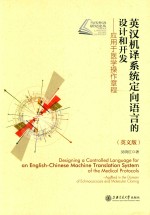

英汉机译系统定向语言的设计和开发:应用于医学操作章程:英文PDF电子书下载
- 电子书积分:20 积分如何计算积分?
- 作 者:吴晓红著
- 出 版 社:
- 出版年份:2017
- ISBN:
- 页数:0 页
Part One Machine Translation and Controlled Language 2
Chapter 1 Machine Translation 2
1.1 Introduction 2
1.2 MT in China 3
1.2.1 Brief introduction 3
1.2.2 MT in China 3
1.3 Types of MT systems 6
1.3.1 Bilingual systems vs.multilingual systems 6
1.3.2 Fully automatic MT systems 6
1.3.3 Human intervened MT systems 7
1.4 The needs of MT systems 7
1.5 The difficulty of translation 8
1.6 The difficulty of MT 10
Chapter 2 Objectives of the thesis 13
2.1 Motivation 13
2.2 The purpose of the thesis 13
2.3 Why is CL preferred in our work? 15
Chapter 3 Controlled Languages 17
3.1 What is a Controlled Language? 17
3.1.1 The characteristics of CLs 17
3.1.2 Human-oriented vs.machine-oriented CLs 18
3.1.3 AECMA Simplified English 19
3.1.4 EasyEnglish 20
3.1.5 KANT system 20
3.1.6 ACE 21
3.2 Advantages and disadvantages of CLs 22
3.2.1 Advantages 22
3.2.2 Disadvantages 23
3.3 Sublanguages 24
3.3.1 Introduction 24
3.3.2 The characteristics of sublanguages 24
3.3.3 Differences between CLs and sublanguages 25
Chapter 4 Medical Protocols 27
4.1 The construction of a sample corpus 27
4.1.1 The choice of the applied domains 27
4.1.2 The criteria of building a corpus 28
4.1.3 The size of the corpus 29
4.1.4 Sample texts 29
4.2 Characteristics of the medical protocols 32
4.2.1 The general styles of the medical protocols 32
4.2.2 The complexity of medical language 32
4.2.3 The characteristics of our protocols 33
4.3 The construction of the CL lexicon 34
4.3.1 Verbs in the lexicon 35
4.3.2 Nouns in the lexicon 37
4.3.3 Prepositions in the lexicon 39
4.3.4 Adjectives in the lexicon 40
4.3.5 Determiners in the lexicon 41
4.4 Management of the lexicon 42
Part Two Linguistic Comparison and Formulation 44
Chapter 5 Lexical Differences and Problems 44
5.1 Introduction 44
5.2 Our investigation 45
5.3 Comparisons at lexical level 47
5.3.1 Morphological differences 47
5.3.2 Semantic differences 51
5.3.3 Grammatical Categories and Grammatical Functions 53
5.3.4 The number of nouns,the English articles and the Chinese classifiers 57
5.4 The TL structural word"DE" 62
Chapter 6 Syntactic Differences and Problems 67
6.1 General syntactic differences(Ⅰ) 67
6.2 Some specific syntactic differences(Ⅱ) 69
6.2.1 Noun phrases and modifications 69
6.2.2 Prepositional phrases,problems and solutions 73
6.2.3 The position of PPs as adjuncts of verbs 87
6.3 At the sentence level 95
6.3.1 Declarative sentences 95
6.3.2 Imperative sentences 97
6.3.3 Adverbial clauses 112
Chapter 7 Translation Information 118
7.1 Introduction 118
7.2 Some principles 118
7.2.1 Accuracy 118
7.2.2 Clarity 119
7.2.3 Easy to formulate 119
7.3 Descriptions 120
7.3.1 Translation problems 120
7.3.2 Lexical information 123
7.3.3 Classifiers 123
7.3.4 Prepositions 124
7.3.5 Adding the structural word“DE(的)” 125
7.3.6 Others 127
Part Three Machine Designing Controlled Language Rules 130
Chapter 8 Designing CL Rules 130
8.1 Introduction 130
8.2 Some aspects and principles 131
8.3 The features of our CL 131
8.4 Particularities of our sub-domain application 132
Chapter 9 Language Control 134
9.1 Introduction 134
9.2 Vocabulary control 134
9.3 Grammar control 136
9.3.1 At phrasal level 136
9.3.2 At sentential level 138
9.4 Style 141
Chapter 10 CL Rule Set 142
10.1 Introduction 142
10.2 Lexical rules 142
10.3 Grammar Rules 147
10.3.1 Noun phrase rules 147
10.3.2 Verb Rules 150
10.3.3 Adjunct Rules 154
10.3.4 Prepositional phrase rules 155
10.3.5 Adjective and adverb rules 160
10.3.6 Conjunction rules for phrases 161
10.4 Sentence rules 162
10.5 Controlled textual rules 166
10.6 Punctuation rules 170
Chapter 11 Translation Process Model 177
11.1 Transfer and Generation 177
11.1.1 The architecture of our system 177
11.1.2 Introduction to the transfer strategy 178
11.2 Demonstration 180
11.3 General Conclusion 186
Annex Corpus 190
Original Protocols 190
Bibliography 206
Index 209
Postscript 212
- 《钒产业技术及应用》高峰,彭清静,华骏主编 2019
- 《现代水泥技术发展与应用论文集》天津水泥工业设计研究院有限公司编 2019
- 《英汉翻译理论的多维阐释及应用剖析》常瑞娟著 2019
- 《药剂学实验操作技术》刘芳,高森主编 2019
- 《数据库技术与应用 Access 2010 微课版 第2版》刘卫国主编 2020
- 《区块链DAPP开发入门、代码实现、场景应用》李万胜著 2019
- 《虚拟流域环境理论技术研究与应用》冶运涛蒋云钟梁犁丽曹引等编著 2019
- 《当代翻译美学的理论诠释与应用解读》宁建庚著 2019
- 《第一性原理方法及应用》李青坤著 2019
- 《程序逻辑及C语言编程》卢卫中,杨丽芳主编 2019
- 《急诊影像诊断学》程晓红责任编辑;(中国)许乙凯 2019
- 《储望华钢琴作品演奏解析》陈国红著 2019
- 《明清白话短篇小说的文学地理研究 上》杨宗红著 2019
- 《艺术家形象的塑造 关于工匠如何成为接受神圣灵感的艺术家的探讨》武红著 2017
- 《我的便携式生活》闫红著 2019
- 《有机食品消费》魏胜,霍红著 2019
- 《计算机专业英语》邱晓红,吴沧海主编 2019
- 《蔬菜重金属控制原理与方法》徐卫红著 2019
- 《中国协商民主体系及其运行机制研究》孙照红著 2019
- 《江户前期理学诗学研究》张红著 2019
